Like a Small Boat on the Ocean
America's Great Lakes offer a unique alternative to congested seaports.
You’re reading Flow of Funds, a Substack newsletter that seeks to dig deeper into the intersection of global supply chains and the businesses that surround them. Please go ahead and subscribe—it’s free!—to get these periodic updates sent directly to your inbox. I wouldn’t send you anything that I would not want to read myself!
The supply chain pain at global seaports is subsiding for now, but the lessons of the ongoing COVID-19 pandemic are leading many businesses towards a rethink of their logistics models. While shipping from Asia to the United States’ West Coast may still make sense, taking the extra time to transit the Panama Canal and offload at Houston or Savannah may be worth the while. Shipments from Europe to the West Coast may see similar tradeoffs, with rail and truck transit completing the landside trip in either situation. But when it comes to directly accessing the Midwestern United States, interior eastern Canada, and the 100 million people that live in the combined region, America’s Great Lakes provide shippers with a unique and undervalued option for shaving time off of their journeys.
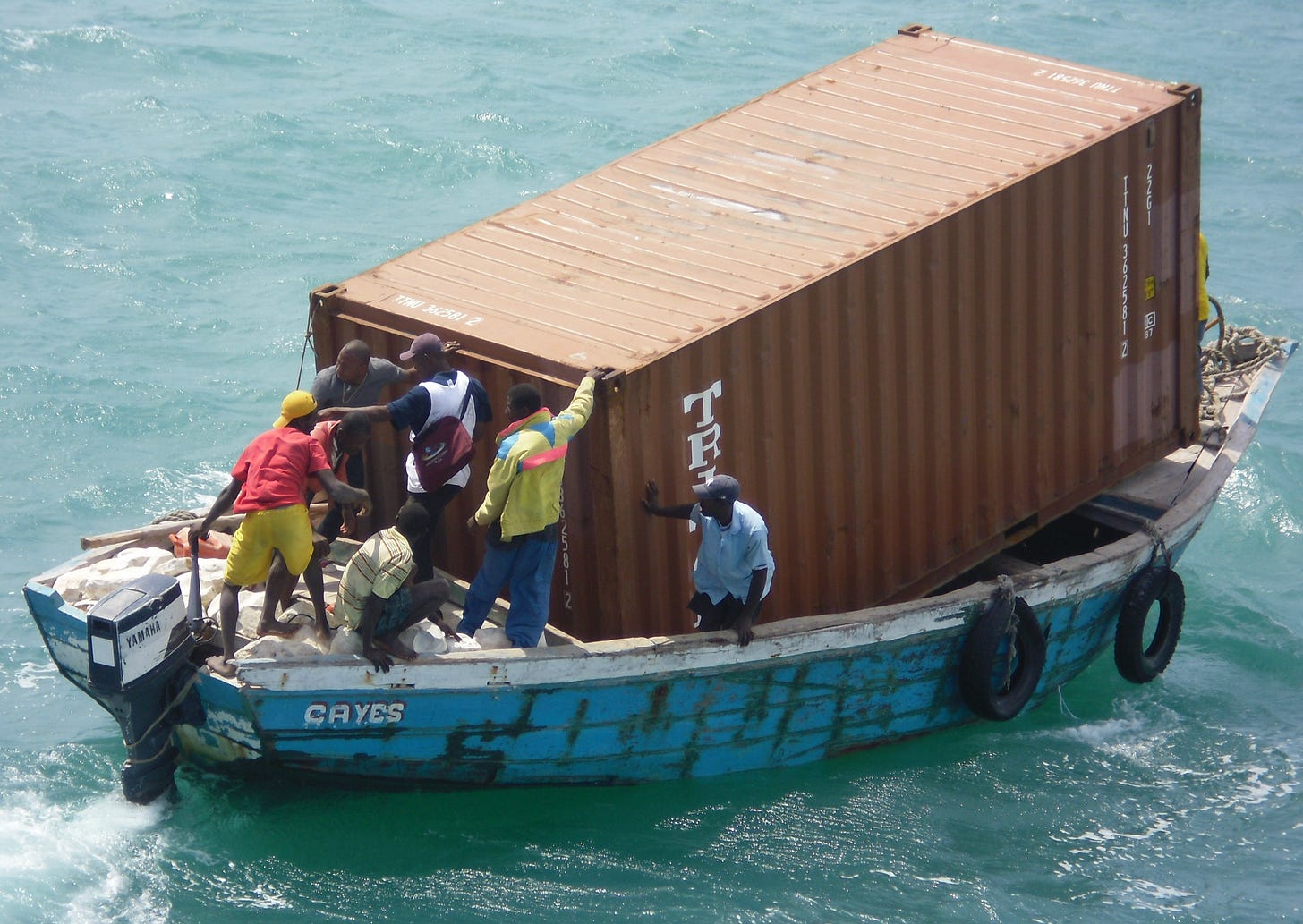
Moving freight from the deepwater megaports at Houston or Savannah is not so simple as to simply steam a container ship ahead north, roll down the St. Lawrence River, and park the boat in one’s Rust Belt city of choice. The shipping decision is more complicated, often subtly so. Ship loading and unloading procedures must be considered, physical constraints limit boat sizes and routes, and economics underly the reality of whether it is all worth it or not.
Fear not the Gear
Notably absent from Great Lakes container ports are the elephantine ship-to-shore gantry cranes that characterize a trip near deepwater ocean ports such as Long Beach or Bayonne. Those shoreside cranes—sometimes automated in conjunction with other port operations—let a container ship carry more containers. With no need to move or offload boxes mid-voyage, larger oceangoing container ships simply have no need for their own loading functionality when they are moving from [major Asian seaport] to [major American seaport].
As compelling a value proposition that Great Lakes container shipping may be, it simply does not merit the investment in multi-million dollar cranes and vending machine-like port functionality that the larger ocean ports do. Instead, the ships must bring their own cranes so they may load and unload at ports which do not have that functionality. These “geared” ships (below) are not as common, but they allow for flexibility in ports of call and berth assignments where landside capabilities may be lacking.
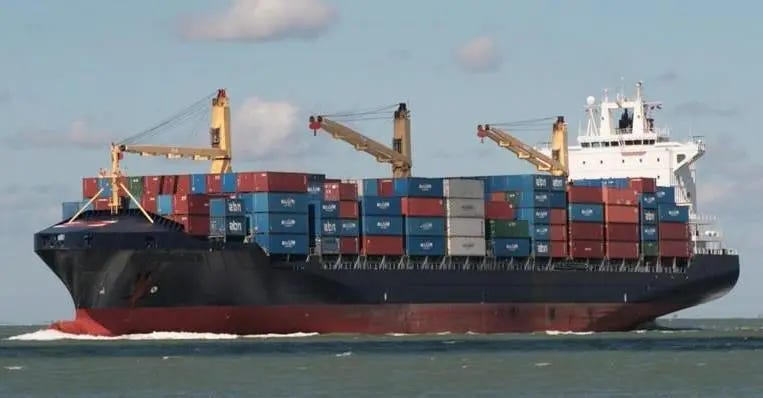
Geared ships are often aided at port by landside “reach stacker” cranes which mimic the functionality of megaport gantry cranes while providing flexibility in navigating often makeshift container yards. In the absence of those, a regular normie crane can do the same with more handling involved (below, illustrative). Time is of course money, though I presume longshoremen on Lake Erie have more time on their hands than those at Long Beach.
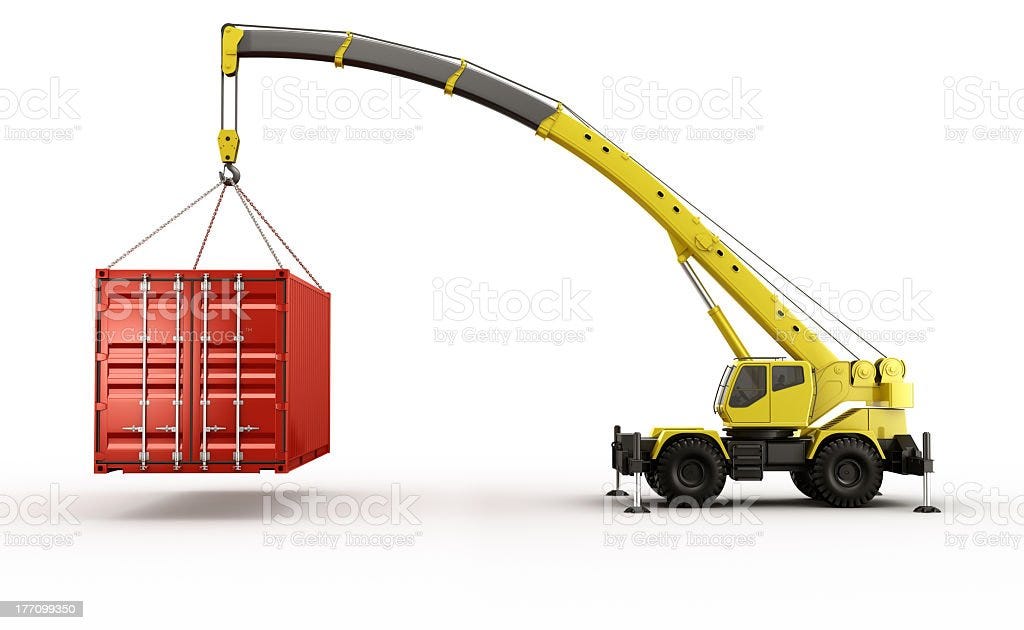
No Leeway on the Seaway
Standing between the Great Lakes and the global marketplace are the locks, canals, and natural channels that comprise the St. Lawrence Seaway. A man-made augmentation of the St. Lawrence River that links Lake Ontario with the Atlantic Ocean, the Seaway provides navigation aids through some of the trickier areas of that river, Lake Ontario, and the Welland Canal, which bypasses Niagara Falls.1
The newest of these locks was finished in the late 1960s and they are not getting any bigger any time soon. In the same way that a chain has a weakest link, the smallest lock of the St. Lawrence Seaway System acts as a constraint for the maximum size ship which may pass through the entire system. Seawaymax ships of this size are limited to 740 feet in length by 78 feet wide, with about 26.5 feet of draft before it bottoms out. This “-max” designation is standard—Panamax ships are the largest which may pass through the Panama Canal, Suezmax ships are built for the Suez Canal, etc.
The Seawaymax ships which serve the Great Lakes are of course much smaller than those that serve deepwater ocean ports. Those ships (often Panamax or Suezmax) can reach over 1,300 feet in length and 200 feet in width, effectively double the size of the Great Lakes-bound vessels. Capesize vessels are even larger: the Cape Agulhas and Cape Horn to which their name refers signals that they must travel around continents themselves and cannot fit through any canals (i.e., shortcuts). They are therefore best suited to non-urgent bulk commodities such as coal and crude oil.
This size constraint forms the basis for many shipping decisions. In a situation where economies of scale must be achieved to drive per-unit (i.e., per-container) costs ever lower, carriers must move as much freight as they possibly can on whichever largest possible ship they can use to serve their route. To make container carriage on the Great Lakes worth the while, they must maximize their loads (the numerator in the equation) vis-à-vis a relatively small ship capacity (the denominator), which is “artificially” constrained by Seaway lock dimensions.
Cash Rules Everything on the Sea
The success of container shipping on the Great Lakes will depend on economics. Shipping in general relies on scale: the 20,000+ TEU behemoths that rule the open oceans do so because their fixed costs can be divided among that many containers, and bulk cargoes such as grains and iron ore are naturally suited to the mode due to their low per-unit values and the often low urgency of their shipments (just imagine shipping iron ore by airplane—why?).
Given the physical constraints of the Seaway system (above), the other way that carriers may offer low freight rates to their customers is through the provision of regularly scheduled, “liner”-style services that serve predetermined routes on regular schedules.2 By offering predictability, shippers may coordinate shipments and work to synchronize their supply chains in ways that indirectly (but substantially) save money. Not scrambling to arrange last-minute shipments and not paying higher ad hoc shipping rates are just as valuable, though not as visible, cost savings.
Predictability in service can only take Great Lakes container carriers so far. Unlike their oceanbound counterparts, which serve port pairs separated by massive seas, shipping on the Great Lakes is merely one option for reaching the coast which competes with trucking and railroad carriage—two modes which are well established (with no small thanks to massive government subsidies over the years) and already occupy the mindspace of supply chain executives. Even at identical freight prices, shippers may prefer to send their cargoes over land to the next nearest seaport instead of exploring the gradient of options in between.
Cleveland is the City
The Spliethoff Group’s Cleveland-Europe Express (CEE) is currently the only major container service operating on the Great Lakes. Centered on the Port of Cleveland, the service calls on Great Lakes ports at that city, Chicago, Duluth (Minn.), and Thunder Bay (Ont.) as well as minor ports along the Seaway before crossing the Atlantic Ocean to Antwerp, Belgium where Spliethoff offers additional transport throughout the rest of Europe over its landside network.3
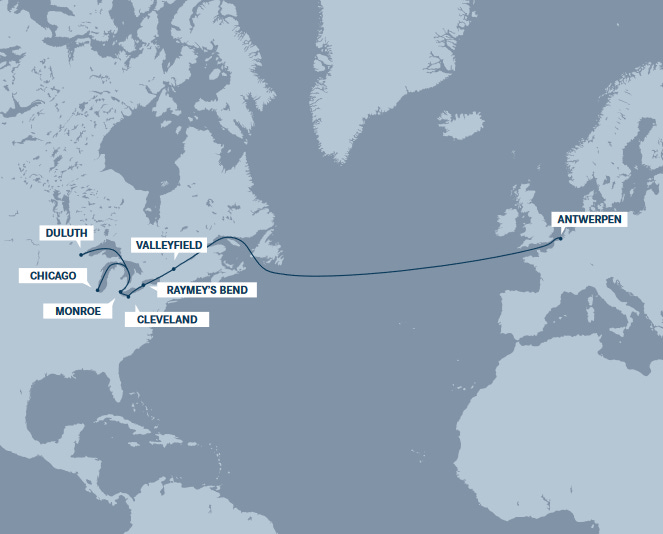
CEE’s twice-monthly sailings represent a relatively small service. Its Peyton Lynn C vessel’s (below) 860 TEU capacity represents about (860 TEU × two legs of a round trip × two round trips monthly × 12 months per year ≈ ) 41,000 TEUs of annual service capacity, which pales in comparison to the total 816 million TEUs that the United Nations Conference on Trade and Development estimates to have crossed the oceans worldwide in 2020. The service appears busy, however, and the other smaller ships that Spliethoff uses to serve the route can carry other, non-containerized cargo as needed to fill remaining capacity.
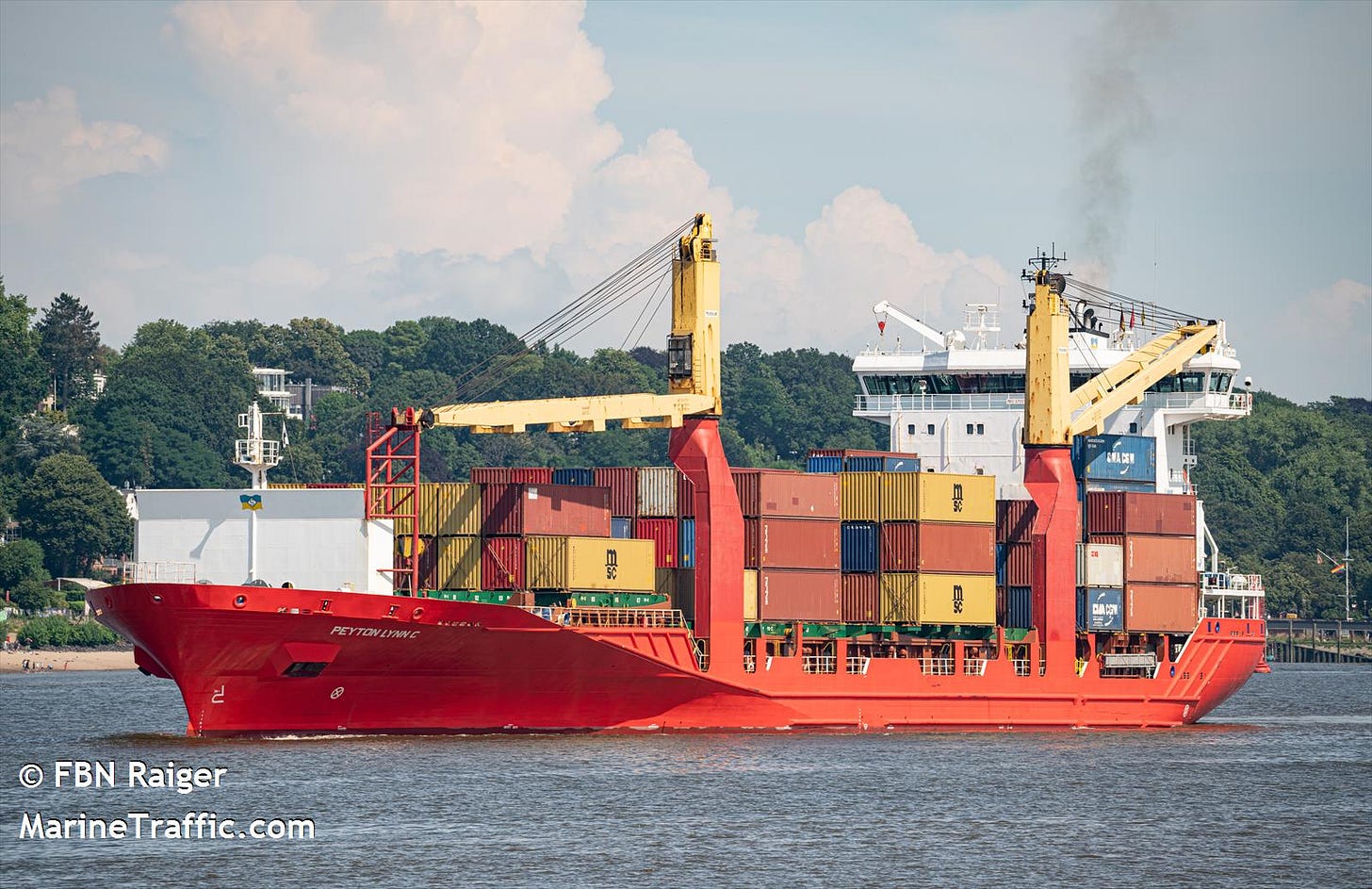
Sailing Entails Scaling
Much like its deepwater counterparts, the success of Great Lakes container shipping is dependent upon its achievement of economies of scale. As much cargo as possible needs to be transported on a given ship to drive per-container costs as low as possible to remain attractive.
Unlike them, however, Great Lakes carriers are more restricted in the size of ships that they may use, limiting the degree to which those costs may be minimized. Also unlike those megacarriers, container carriage on the Great Lakes sits in direct competition with other modes of transport—particularly, trucks and railroads which are already well established both physically and in the minds of their users. Container shipping on the Great Lakes may be attractive for some, but a larger push may be needed to turn it into a trend.
An additional Great Lakes lock system exists at Sault Ste. Marie, at the top of Michigan’s mitten, which is separately run by the U.S. Army Corps of Engineers. These “Soo” locks (an Anglicized spelling of Sault) are larger than those of the Seaway and therefore provide no additional size impediments.
“Tramp” shipping, the alternative to liner shipping, involves one-off voyages between whichever ports the customer desires—imagine hailing a taxi (tramp service) versus hopping on the bus (liner service). While tramp shippers can offer lower rates due to their lower overhead costs (they are often single-vessel businesses), the complexities of container shipping by nature limit tramp shipping to the bulk (i.e., non-containerized) trades where a single (or very few) client(s) fill an entire boat. The administrative work involved in coordinating thousands of containers (and by extension, customers) essentially limits container shipping to the liner trade where it can enjoy greater economies of scale.
It is worth noting that the Cleveland-Europe Express cannot carry containers between American ports—the Jones Act limits this so-called cabotage to American-built, flagged, and crewed ships. CEE’s flagship Peyton Lynn C is none of those. It may call on various American ports as often as it likes, but specific cargoes must only be loaded in the States and offloaded abroad (or vice versa).




